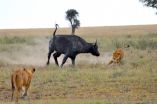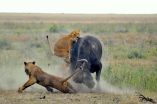U of G ecologists wondering where the lions -- and other top predators -- are
2015-09-03
(Press-News.org) Why are there not more lions when there's plenty of prey on the African savanna?
A research team including two University of Guelph ecologists has discovered an unexpected pattern linking prey and predator species in diverse ecosystems worldwide.
Integrative biology professors John Fryxell and Kevin McCann co-authored the paper, published today in Science. The team included researchers at McGill University, the University of British Columbia and the Perimeter Institute for Theoretical Physics in Waterloo, Ont.
Beyond lions and the gazelles they hunt on the African savanna, the pattern extends to all organisms studied by the team, from the smallest plankton-eating crustaceans in the oceans to the biggest fish in lakes and streams.
The team found that relative amounts of predator and prey biomass in diverse ecosystems around the globe are "remarkably well-predicted by a simple mathematical function called a power scaling law," said McCann.
The resulting "power law" shows there are always fewer top predators than expected in resource-rich ecosystems than in resource-poor ecosystems.
The researchers looked at biomass and production measurements in grasslands, forests, lakes and oceans. They analyzed results of more than 1,000 earlier studies conducted in more than 1,500 locations worldwide.
No matter where they looked, they found the same predator-prey ratios. "We kept being astonished," said McCann. "This is just an amazing pattern."
As you add more individuals of prey species to a resource-rich ecosystem such as the savanna, you might expect the biomass of predators to increase at the same rate, said Fryxell.
Instead, the ratio of predators to prey falls dramatically in that productive grassland.
"What is it about a productive system that accounts for reduced predator success?" he said. "When a system is teeming with prey, why are predators leaving so much food on the table?"
Biologists don't yet have all the answers.
Fryxell said prey species reproduce more slowly in the most abundant and species-rich ecosystems, which might affect the predator-prey power law.
He said the paper calls for a new look at ecological mechanisms that shape food-webs in similar ways around the planet.
Understanding these processes will likely yield better ways of conserving and managing natural resources, said Fryxell.
INFORMATION:
ELSE PRESS RELEASES FROM THIS DATE:
2015-09-03
This news release is available in Japanese.
Regular exposure to bacteria particles and farm dust protects children from allergies because it blunts their inflammatory immune responses, a new mouse study suggests. The study implicates a particular anti-inflammatory enzyme, A20, in this protective effect. While aspects of how allergies develop remain unclear, scientists know they're driven not only by genes but also by environment. Homes with pets, as well as dairy farms - where children breathe dust containing higher doses of fungal particles, cowshed-derived bacteria ...
2015-09-03
This news release is available in Japanese.
Ecological communities around the world are richly varied, but a new study finds that many of these diverse communities follow an unexpected, yet consistent pattern: where prey are abundant, there are not proportionally more predators. Instead, as prey biomass increases, the ratio of predator-to-prey biomass decreases. This pattern was systematically identified across different areas, including grasslands, forests, lakes, and oceans, revealing an underlying structural organization of ecosystems. Pinpointing underlying ...
2015-09-03
This news release is available in Japanese.
Researchers have identified a mutation in plants that allows them to break down TNT, an explosive that has become highly prevalent in soil in the last century, particularly at manufacturing waste sites, mines, and military conflict zones. TNT, or 2,4,6-trinitrotoluene, is a toxic and persistent environmental pollutant that accumulates in the roots of plants, inhibiting growth and development. The identification of a plant mechanism that not only evades the negative impacts of TNT, but breaks down this harmful substance could ...
2015-09-03
This news release is available in Japanese.
A special news edition, Science in Iran, looks closely at the scientific challenges and triumphs of a country that has faced international isolation in recent years. Following an exclusive interview about the Iran nuclear deal with Ali Akbar Salehi, president of the Atomic Energy Organization of Iran, Science International News Editor Richard Stone delves further into the state of Iran's scientific endeavors. Decades of economic sanctions have deprived Iranian scientists of critical scientific resources and collaboration. ...
2015-09-03
Biologists at the University of York have taken an important step in making it possible to clean millions of hectares of land contaminated by explosives.
A team from the Centre for Novel Agricultural Products (CNAP) in the University's Department of Biology has unravelled the mechanism of TNT toxicity in plants raising the possibility of a new approach to explosives remediation technology. TNT has become an extensive global pollutant over the last 100 years and there are mounting concerns over its toxicity to biological systems.
The study, which is published in Science, ...
2015-09-03
Researchers at VIB (a leading life sciences institute in Flanders, Belgium) and Ghent University have successfully established a causal relationship between exposure to so-called farm dust and protection against asthma and allergies. This breakthrough discovery is a major step forward towards the development of an asthma vaccine. The results of the research were published in the leading journal Science.
It is commonly known that drinking raw cow's milk can provide protection against allergies. A 14-member research team, led by professors Bart Lambrecht and Hamida Hammad ...
2015-09-03
Evidence from a new study published in PLOS Computational Biology by researchers from Brown University and led by Assistant Professor Thomas Serre suggests that when we analyze scenery we simply make the easiest judgments first, rather than following a priority order of categories.
There are many ways we understand scenery. Is it navigable or obstructed? Natural or man-made? A face or not a face? In previous experiments, researchers have found that some categorization tasks seem special, in that they occur earlier than others, leading to a hypothesis that the brain has ...
2015-09-03
Rodents huddle together when it is cold, they separate when it is warm, and at moderate temperatures they cycle between the warm center and the cold edges of the group. In a new study published in PLOS Computational Biology, Jonathan Glancy, Roderich Gross, Jim Stone and Stuart Wilson from the University of Sheffield found they could simulate huddling by assuming simply that touching individuals in turn brings their temperatures closer to an ideal body temperature. According to the model, these selfish individual behaviours improved the ability of the whole group to regulate ...
2015-09-03
Why aren't there more lions? That was what puzzled McGill PhD student Ian Hatton, when he started looking at the proportion of predators to prey across dozens of parks in East and Southern Africa. In this case, the answer had nothing to do with isolated human hunters. The parks were teeming with potentially tasty treats for the lions. So one might imagine that the population of lions in each park would increase to match the available prey. Instead, what Hatton and the McGill-led team discovered was that, in a very systematic way, in crowded settings, prey reproduced less ...
2015-09-03
CAMBRIDGE, Mass. (September 3, 2015) - A protein known to play a role in transporting the molecular contents of normal cells into and out of various intracellular compartments can also turn such cells cancerous by stimulating a key growth-control pathway.
By conducting a large-scale search for regulators of the signaling pathway known as PI3K/AKT, which promotes cell survival, growth, and proliferation--and which is highly active in cancer cells--researchers at Whitehead Institute and Memorial Sloan-Kettering Cancer Center have implicated the protein RAB35 in the oncogenic ...
LAST 30 PRESS RELEASES:
[Press-News.org] U of G ecologists wondering where the lions -- and other top predators -- are



